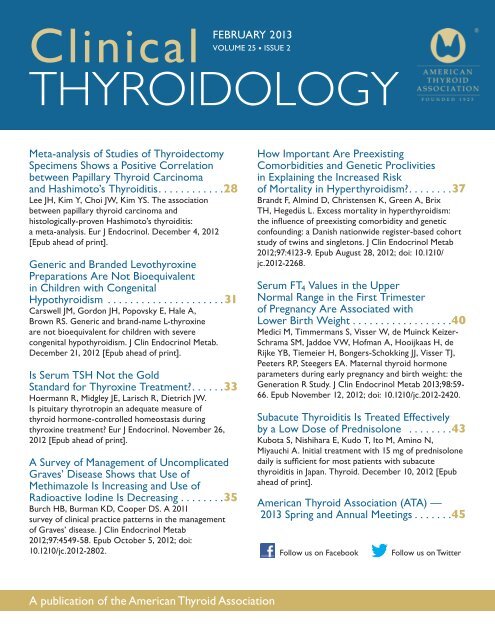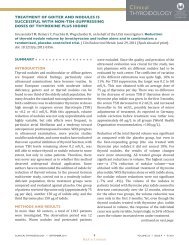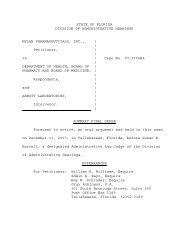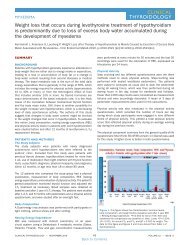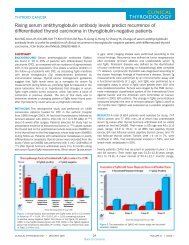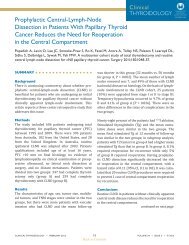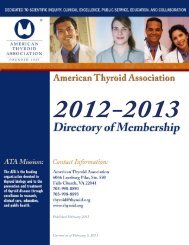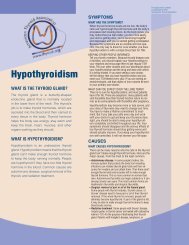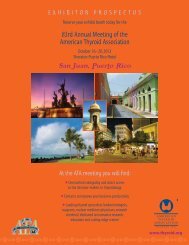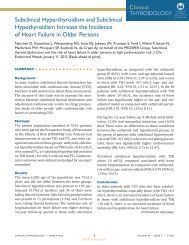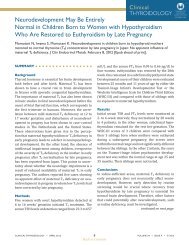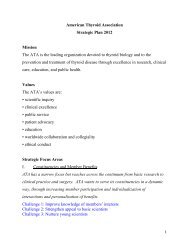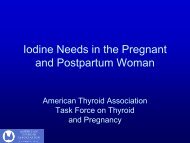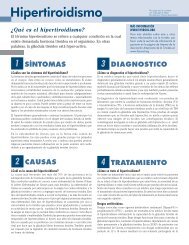Clinical Thyroidology February 2013 Entire Issue - American Thyroid ...
Clinical Thyroidology February 2013 Entire Issue - American Thyroid ...
Clinical Thyroidology February 2013 Entire Issue - American Thyroid ...
You also want an ePaper? Increase the reach of your titles
YUMPU automatically turns print PDFs into web optimized ePapers that Google loves.
<strong>Clinical</strong>THYROIDOLOGYVOLUME 25 • ISSUE 2 FEBRUARY <strong>2013</strong>Clin <strong>Thyroid</strong>ol <strong>2013</strong>;25:28–30.Editor-in ChiefJerome M. Hershman, MDDistinguished Professor of MedicineUCLA School of Medicineand VA Greater Los Angeles Healthcare SystemEndocrinology 111D, 11301 Wilshire Blvd.Los Angeles, CA 90073Email: jhershmn@ucla.eduAssociate Editors:Albert G. Burger, MDProfessor, University of GenevaGeneva, SwitzerlandEmail: agburger@bluewin.chJorge H. Mestman, MDProfessor of <strong>Clinical</strong> Medicine and OB/GYNUniversity of Southern California,Keck School of MedicineLos Angeles, CAEmail: mestman@usc.eduElizabeth N. Pearce, MD, MScAssociate Professor of MedicineBoston University School of MedicineBoston, MAEmail: Elizabeth.pearce@bmc.orgWendy Sacks, MDCedars-Sinai Medical CenterDepartment of MedicineHealth Sciences Assistant <strong>Clinical</strong> ProfessorUniversity of California, Los Angelesemail: wendy.sacks@cshs.orgStephen W. Spaulding, MDProfessor of MedicineDepartment of MedicineUniversity at Buffalo, SUNYEmail: medspaul@buffalo.eduCord Sturgeon, MDAssociate Professor of SurgeryDirector of Endocrine SurgeryNorthwestern UniversityFeinberg School of MedicineChicago, ILEmail: csturgeo@nmh.orgPresidentBryan R. Haugen, MDSecretary/Chief Operating OfficerJohn C. Morris, MDTreasurerDavid H. Sarne, MDPresident-ElectHossein Gharib, MDPast-PresidentJames A. Fagin, MDTreasurer-ElectGregory W. Randolph, MDExecutive DirectorBarbara R. Smith, CAE<strong>American</strong> <strong>Thyroid</strong> Association6066 Leesburg Pike, Suite 550Falls Church, VA 22041Telephone: 703-998-8890Fax: 703-998-8893Email: thyroid@thyroid.orgDesigned ByKaren Durland (kdurland@gmail.com)<strong>Clinical</strong> <strong><strong>Thyroid</strong>ology</strong>Copyright © <strong>2013</strong><strong>American</strong> <strong>Thyroid</strong> Association, Inc.Printed in the USA. All rights reserved.Meta-analysis of Studies of<strong>Thyroid</strong>ectomy Specimens Showsa Positive Correlation betweenPapillary <strong>Thyroid</strong> Carcinoma andHashimoto’s <strong>Thyroid</strong>itisKaren T. Le, Bojana Jankovic,and Jerome M. HershmanLee JH, Kim Y, Choi JW, Kim YS. The association between papillarythyroid carcinoma and histologically-proven Hashimoto’s thyroiditis: ameta-analysis. Eur J Endocrinol. December 4, 2012 [Epub ahead of print].SUMMARYBackgroundHashimoto’s thyroiditis (HT) is found in a high proportion of resected thyroidspecimens. There has been considerable controversy as to whether having HTpredisposes a patient to papillary thyroid cancer (PTC). This study is a metaanalysisdesigned to clarify the relationship between PTC and histologicallydemonstrated HT and to investigate the clinical and pathologic features of PTCwith coexistent HT.MethodsThe authors performed an extensive literature search for articles that hadprimary data showing an association of PTC and “classical HT” based on histopathologicexamination of thyroid specimens. Articles lacking pathologic datawere excluded. On the basis of these criteria, 38 studies were selected for themeta-analysis.Odds ratios (OR) with 95% confidence intervals (CI) were calculated andcombined using a random-effects model.continued on next pageBack to Contents28
Meta-analysis of Studies of <strong>Thyroid</strong>ectomy SpecimensShows a Positive Correlation between Papillary<strong>Thyroid</strong> Carcinoma and Hashimoto’s <strong>Thyroid</strong>itisLee JH, et al.ResultsThe 38 studies consisted of 37 case–control studiesand one cohort study. The number of patients in eachstudy ranged from 6 to1788, with a total of 10,648PTC cases. Only 11 studies compared the frequencyof HT in cases of PTC and benign thyroid disease. HTwas found in 938 of 2317 (40.5%) of PTC cases and in634 of 3019 (21%) of benign cases (OR, 2.77;95% CI,1.95 to 3.93; P
Meta-analysis of Studies of <strong>Thyroid</strong>ectomy SpecimensShows a Positive Correlation between Papillary<strong>Thyroid</strong> Carcinoma and Hashimoto’s <strong>Thyroid</strong>itisLee JH, et al.based on the Q values provided. The authors of thepresent study sought to examine the clinical behaviorof PTC with coexisting HT by investigating sex, age,tumor size, tumor extension, lymph-node metastasis,multifocality, and survival analysis. Among seven clinicopathologiccharacteristics, survival analysis andtumor extension were the only two that did not havesignificant heterogeneity, allowing valid conclusionsto be reached.There were two study results that appear to be inconsistentwith the conclusions presented by the authors:the results pertaining to tumor extension and lymphnodemetastasis. HT was found in 17.5% of 4128PTCs without extrathyroidal extension and in 17.2%of 2897 PTCs with extrathyroidal extension. Theauthors concluded that the coexistence of HT in PTCswas associated with no extrathyroidal involvement.However, the equal prevalence of HT in PTC with andwithout extrathyroidal extension suggests no relationship.Similarly, HT was present in 17.8% of 4185 PTCswithout lymph-node metastasis and in 17.9% of 3462PTCs with lymph-node metastasis, suggesting no relationship.However, the authors concluded that therewas a positive relationship between the coexistence ofHT and PTC and the absence of lymph-node metastasis.This is the second largest meta-analysis to evaluate theassociation between PTC and HT. It provides a detailedreview of the literature about the ongoing debate.However, studies of archival thyroidectomy specimensshould be interpreted with caution. Although theyprovide valuable information about the correlationbetween the two entities, a significant positive associationappears to be observed only in this high-riskpopulation of patients whose disease state leads toa thyroidectomy. We suggest that this association inarchived thyroidectomy specimens should not be usedin making a decision about management of a thyroidnodule in a patient with Hashimoto’s thyroiditis.Instead the decision should be based, as usual, on theresult of the FNA cytopathology.References1. Matesa-Anić D, Matesa N, Dabelić N, KusićZ. Coexistence of papillary carcinoma andHashimoto’s thyroiditis. Acta Clin Croat2009;48:9-12.2. Anil C, Goksel S, Gursoy A. Hashimoto’s thyroiditisis not associated with increased risk of thyroidcancer in patients with thyroid nodules: a singlecenterprospective study. <strong>Thyroid</strong> 2010;20:601-6.3. Jankovic B, Le KT, Hershman JM. Hashimoto’sthyroiditis and papillary thyroid carcinoma: isthere a correlation? J Clin Endocrinol Metab.January 4, <strong>2013</strong> [Epub ahead of print].CLINICAL THYROIDOLOGY • FEBRUARY <strong>2013</strong> 30 VOLUME 25 • ISSUE 2 • © <strong>2013</strong>Back to Contents
Clin <strong>Thyroid</strong>ol <strong>2013</strong>;25:33–34.Is Serum TSH Not the GoldStandard for Thyroxine Treatment?Albert G. Burger<strong>Clinical</strong>THYROIDOLOGYHoermann R, Midgley JE, Larisch R, Dietrich JW. Is pituitary thyrotropin an adequate measure of thyroidhormone-controlled homeostasis during thyroxine treatment? Eur J Endocrinol. November 26, 2012[Epub ahead of print].SUMMARYBackgroundThis article is complementary to several recent articles,one from the authors of the current article and onerecently reviewed by me in <strong>Clinical</strong> <strong><strong>Thyroid</strong>ology</strong>(1-3). The authors raise the question of whether thecurrent approach, monitoring thyroxine treatmentwith the serum TSH alone, is adequate. To answer thisquestion, they studied serum FT 4 and FT 3 levels in thyroxine-treatedpatients and compared them with thoseof untreated subjects.MethodsThe study was done between October 2006 andJanuary 2007. The first blood samples of 1994 patientsseen in a thyroid clinic were studied. The median ageof the patients (predominantly women) was 61 years.<strong>Thyroid</strong> antibodies were not measured routinely. Atotal of 1059 patients were untreated—they did notreceive any thyroid hormone or other drug treatment;50 patients were given iodine supplementation alone(100 to 200 µg per day). Of the 190 patients with hypothyroidism,only 53 (28%) had autoimmune disease;in the rest of the group, hypothyroidism was due tosurgery and radioactive iodine treatment.The patients were treated with 50 to 200 µg of levothyroxinedaily. Subclinical hyperthyroidism wasdefined by a serum TSH below the reference range(
Clin <strong>Thyroid</strong>ol <strong>2013</strong>;25:37–39.<strong>Clinical</strong>THYROIDOLOGYHow Important Are Preexisting Comorbiditiesand Genetic Proclivities in Explaining the IncreasedRisk of Mortality in Hyperthyroidism?Stephen W. SpauldingBrandt F, Almind D, Christensen K, Green A, Brix TH, Hegedüs L. Excess mortality in hyperthyroidism:the influence of preexisting comorbidity and genetic confounding: a Danish nationwide register-basedcohort study of twins and singletons. J Clin Endocrinol Metab 2012;97:4123-9. Epub August 28, 2012; doi:10.1210/jc.2012-2268.SUMMARYBackgroundPatients with hyperthyroidism have an increasedrisk of mortality. Clearly the associated atrial fibrillation,coagulopathies, and thromboembolism canincrease mortality, but the importance of preexistingdiseases and of different genetic backgrounds remainto be established. The authors report a retrospectivepopulation-based study, using a variety of Danishdatabases, to begin to address some of these issues.MethodsAll twins born in Denmark since 1954 have beenentered in a twin registry, and the vital status and causeof death for everyone in Denmark has been recordedsince 1968. Since 1977, all hospital discharge InternationalClassification of Diseases, 8th (ICD8) or 10th(ICD10) Revision diagnoses—and since 1995, theICD diagnoses for all outpatient hospital clinic visitsand all purchases of antithyroid drugs—have alsobeen recorded. The authors randomly selected 5%(339,481) of all patient records, and then excludedabout 60,000 patients who were under 18 years of ageor had died before 1977. From the remainder, all whohad been given one of the ICD codes for hyperthyroidismand/or who had purchased antithyroid drugs atleast twice since 1995 were identified, and the causeof death (or survival up to the end of 2008) was determined.Hyperthyroidism was found in 4850 patientswho had been single births. From the twin registry,hyperthyroidism was identified in 926 same-sextwins, and 625 had a twin pair who did not havehyperthyroidism up to 2008. Four controls, matchedfor age and sex, were obtained for each singleton withhyperthyroidism, while for each twin with hyperthyroidism,four nonrelated non-control twins who didnot have hyperthyroidism, matched for age, sex, andzygosity, were obtained. The Charlson comorbidityindex—a weighted sum for 19 common medicalconditions, which predicts 1-year mortality—wascalculated for each patient and control, based on ICDcodes. Pearson chi-square tests were used to comparegroup frequencies, t-tests to test group means, Mann–Whitney tests for group medians, and paired t-testsfor paired comparisons.ResultsEach group with hyperthyroidism had more comorbiditythan its control group. The risk for mortalityin the 4850 singleton patients with hyperthyroidismwas increased by 37% (hazard ratio [HR], 1.37; 95%confidence interval [CI], 1.30 to 1.46), as comparedwith their controls over a mean of 10 years of followup.After adjusting for sex and comorbidity, essentiallythe same results were obtained. The 2065singleton patients with hyperthyroidism who had nodocumented comorbidity before their hyperthyroidismhad been diagnosed still had an increased risk formortality (HR, 1.28; 95% CI, 1.21 to 1.36), suggestingthe hyperthyroidism was directly associated with theincreased mortality.In the 625 twin pairs discordant for hyperthyroidism,the HR for mortality was 1.43 (95% CI, 1.09 to 1.88),continued on next pageCLINICAL THYROIDOLOGY • FEBRUARY <strong>2013</strong> 37 VOLUME 25 • ISSUE 2 • © <strong>2013</strong>Back to Contents
How Important Are Preexisting Comorbiditiesand Genetic Proclivities in Explaining the IncreasedRisk of Mortality in Hyperthyroidism?Brandt F, et al.as compared with the euthyroid sibling, over a meanfollow-up period of 10.5 years. A similar increasewas found when the twin with hyperthyroidism wascompared with its four control twins. In the 418same-sex dizygous twin pairs, the HR was 1.80 (95%CI, 1.27 to 2.55), as compared with the euthyroidsibling. In marked contrast, when the 201 monozygoustwin pairs were compared, the mortality in thesibling with hyperthyroidism was not significantlydifferent from that of the unaffected sibling. Whenthe 413 twins who had had no comorbidity prior tothe diagnosis of hyperthyroidism were studied, againthe dizygous twins with hyperthyroidism still hadincreased mortality, yet the monozygous twins withhyperthyroidism did not.ConclusionsIn singletons with hyperthyroidism as well as insame-sex dizygous twin pairs discordant for hyperthyroidism,the risk of mortality is increased, independentof any medical conditions documentedbefore the diagnosis of hyperthyroidism was made.In contrast, mortality in same-sex monozygous twinsdiscordant for hyperthyroidism may be more influencedby genetic factors.ANALYSIS AND COMMENTARYOne might question the validity of lumping twinswith Graves’ disease together with twins with toxicnodular goiter, because of the well-recognizedgenetic component of Graves’ disease. It therefore isworth noting that Swedish patients hospitalized withtoxic nodular goiter were found to have twice the riskof having a sibling who also had toxic nodular goiter,versus the risk of patients hospitalized with Graves’having a sibling with Graves’ disease, although thenumber with toxic nodular goiter was much smallerthan the number with Graves’ disease (1). Over the31 years that the Danish data were being recorded,methods of testing, diagnostic criteria, and therapiesfor many diseases improved, and some of the deathcodes used and the individuals who performed thecoding underwent changes. Furthermore, the relativefrequency of different causes of hyperthyroidism inDenmark also changed, since dietary iodine levelsand the relative incidence of Graves’ disease versustoxic nodules underwent major shifts during theperiod of the study. In addition, subacute hyperthyroidismand transient hyperthyroidism due to thyroiditisbecame better recognized. Another issue isthe possibility that hyperthyroidism was induced inpatients with preexisting cardiovascular conditionswhen iodine-containing drugs or contrast agentswere administered. The assessment of comorbiditiesmay also be incomplete, since some diseasesknown to be associated with hyperthyroidism, aswell as some complications known to be producedby therapies for hyperthyroidism, might not havebeen noted in the Charlson score, as it is based ononly 19 common diseases.Information concerning thyroid-function tests,therapies used, the period between diagnosis andrestoration of euthyroidism, recurrences, and soforth was not available. It might have been instructiveto show the survival curves after hyperthyroidismwas diagnosed, in view of earlier studiesshowing that the excess mortality after treatmentwith radioiodine occurred mostly in the first year(2), and also to look for possible time trends in thecauses of mortality.Notwithstanding these caveats, such studies are verydifficult to do, and are important if we are to eventuallyunderstand why (and when) patients with hyperthyroidismare at increased risk of mortality.continued on next pageCLINICAL THYROIDOLOGY • FEBRUARY <strong>2013</strong> 38 VOLUME 25 • ISSUE 2 • © <strong>2013</strong>Back to Contents
How Important Are Preexisting Comorbiditiesand Genetic Proclivities in Explaining the IncreasedRisk of Mortality in Hyperthyroidism?Brandt F, et al.References1. Hemminki K, Shu, X, Li X, Ji J, Sundquist K,Sundquist J. Familial risks for hospitalizedGraves’ disease and goiter. Eur J Endocrinol2009;161:623-9. Epub August 6, 2009; doi:10.1530/EJE-09-0349.2. Franklyn JA, Maisonneuve P, Sheppard MC,Betteridge J, Boyle P. Mortality after the treatmentof hyperthyroidism with radioactive iodine. NEngl J Med 1998;338:712-8.www.thyroid.orgWe invite you to join the ATA!Are You Intrigued by the Study of the <strong>Thyroid</strong>? You Belong in the ATA!• ATA members are leaders in thyroidology who promote excellence andinnovation in clinical care, research, education, and public policy.• Join us as we advance our understanding of the causes and improve the clinicalmanagement of thyroid diseases in this era of rapid pace biomedical discovery.• A close-knit, collegial group of physicians and scientists, the ATA is dedicatedto the reseach and treatment of thyroid diseases. ATA's rich history dates back to1923 and its members are respected worldwide as leaders in thyroidology.• The ATA encourages you to apply for membership. We want you to experience thewealth of knowledge and enjoy the benefits of being active in this highly specializedand regarded society. The ATA looks forward to having you as a member!CLINICAL THYROIDOLOGY • FEBRUARY <strong>2013</strong> 39 VOLUME 25 • ISSUE 2 • © <strong>2013</strong>Back to Contents
Clin <strong>Thyroid</strong>ol <strong>2013</strong>;25:40–42.<strong>Clinical</strong>THYROIDOLOGYSerum FT 4 Values in the Upper NormalRange in the First Trimester of PregnancyAre Associated with Lower Birth WeightJorge H. MestmanMedici M, Timmermans S, Visser W, de Muinck Keizer-Schrama SM, Jaddoe VW, Hofman A, HooijkaasH, de Rijke YB, Tiemeier H, Bongers-Schokking JJ, Visser TJ, Peeters RP, Steegers EA. Maternal thyroidhormone parameters during early pregnancy and birth weight: the Generation R Study. J Clin EndocrinolMetab <strong>2013</strong>;98:59-66. Epub November 12, 2012; doi: 10.1210/jc.2012-2420.SUMMARYBackgroundMaternal hyperthyroidism during pregnancy isassociated with an increased risk of low birthweight, resulting in a predisposition to neonatalmorbidity and mortality. The objective of theauthors was to study the effects on birth weight ofearly pregnancy maternal serum thyroid parameterswithin the normal range, as well as the relationbetween umbilical-cord thyroid parameters andbirth weight.MethodsIn early pregnancy, serum TSH, FT 4 , and thyroid peroxidaseantibody levels were determined in 4464pregnant women. Cord serum TSH and FT 4 levelswere determined in 2724 newborns. Small size forgestational age at birth (SGA) was defined as a gestationalage–adjusted birth weight below the 2.5thpercentile. The associations between normal-rangematernal and cord thyroid parameters, birth weight,and SGA were studied using regression analyses.ResultsIn mothers with normal-range FT 4 and TSH levels,higher maternal FT 4 levels were associated withlower birth weight (P = 1.6x10–5), as well as with aslightly increased risk of SGA newborns (odds ratio,1.09; 95% confidence interval, 1.01 to 1.17; P = 0.03).Birth weight was positively associated with both cordTSH (P = 0.007) and cord FT 4 levels (P = 9.2x10–13).ConclusionsThe authors showed that maternal high-normal FT 4levels in early pregnancy are associated with lowerbirth weight and an increased risk for the deliveryof SGA newborns. In addition, birth weight is positivelyassociated with cord TSH and FT 4 levels. Theauthors postulated that even mild variation in thyroidfunction within the normal range can have importantconsequences for the fetus.ANALYSIS AND COMMENTARYIn the past two decades, several population studiesreported an association between euthyroid autoimmunedisease, mild thyroid dysfunction (includingisolated maternal hypothyroxinemia), and abnormalpregnancy outcome (mainly, but not limited to miscarriages,prematurity, and impaired neurodevelopmentin the offspring). Not all the studies are consistent,with the same type and frequency of complications.Several major factors may have contributed to this,among them, iodine status in a given population, lackof thyroid-test trimester-specific reference intervalsfor each population, and exclusion of complicationsintrinsic to pregnancy, such as gestational diabetescontinued on next pageCLINICAL THYROIDOLOGY • FEBRUARY <strong>2013</strong> 40 VOLUME 25 • ISSUE 2 • © <strong>2013</strong>Back to Contents
Clin <strong>Thyroid</strong>ol <strong>2013</strong>;25:43–44.<strong>Clinical</strong>THYROIDOLOGYSubacute <strong>Thyroid</strong>itis Is Treated Effectivelyby a Low Dose of PrednisoloneJerome M. HershmanKubota S, Nishihara E, Kudo T, Ito M, Amino N, Miyauchi A. Initial treatment with 15 mg of prednisolonedaily is sufficient for most patients with subacute thyroiditis in Japan. <strong>Thyroid</strong>. December 10, 2012 [Epubahead of print].SUMMARYBackgroundSubacute (granulomatous, DeQuervain’s) thyroiditisis an uncommon condition that has been treated witheither nonsteroidal antiinflammatory drugs (NSAIDs)or corticosteroids for many years. The response tosteroids is often more dramatic and quicker thanthe response to NSAIDs, but physicians are reluctantto use corticosteroids for this usually self-limiteddisorder because of their well-known side effects.The usual initial dose is 40 mg of prednisone. Thebasis for this dose has not been established by prospectivestudies. The current report is an evaluationof the efficacy of a prednisolone dose of 15 mg perday for 2 weeks, with reduction of the dosage by 5 mgevery 2 weeks, as patients are carefully followed.MethodsSubacute thyroiditis was diagnosed based on the criteriaof swelling, pain, and tenderness within the thyroidgland associated with increased FT 4 , decreased TSH,increased C-reactive protein (CRP), and a hypoechoicarea in the thyroid ultrasonogram corresponding to thetender area. Patients were treated with 15 mg of prednisoloneper day for 2 weeks with reduction of the doseby 5 mg every 2 weeks for 6 weeks. If pain continuedor the CRP remained high, prednisolone treatment wasextended and then tapered over 12 weeks. All patientsreceived “anti-ulcer” drugs.ResultsFrom <strong>February</strong> 2005 through December 2008, thediagnosis of subacute thyroiditis was made in 384patients; 54 were not treated with medication, 33were treated with NSAIDs, 9 dropped out of thetreatment protocol, 69 violated the protocol, and219 followed the protocol and are the subjects of thisreport. Patients were followed every 2 weeks.The mean age of the patients was 49 years, 88% werewomen, and the mean weight was 55 kg. The meanFT 4 was 2.5 ng/dl (normal range, 0.7 to 1.6) and themean FT 3 was 7.15 pg/ml (normal range, 1.70 to3.70); FT 4 was elevated in 80% of the patients.<strong>Thyroid</strong>itis improved in 6 weeks and did not recur in113 patients (51.6%); 106 patients took prednisolonefor 7 weeks or longer and 27 of them took prednisolonefor more than 12 weeks. Seven patients required>15 mg per day; 2 of these patients were treated with30 mg per day and 5 with 20 mg per day. About 20%took more than 8 weeks to recover. There was a significantnegative correlation between the FT 4 andthe duration of therapy and between the FT 3 and theduration of therapy.Transient hypothyroidism occurred in 31% ofpatients, and permanent hypothyroidism was foundin only 3.6% of patients.ConclusionsSubacute thyroiditis can be treated effectively with adaily dose of 15 mg of prednisolone for 2 weeks andsubsequently tapering by 5 mg per day every 2 weeks.continued on next pageCLINICAL THYROIDOLOGY • FEBRUARY <strong>2013</strong> 43 VOLUME 25 • ISSUE 2 • © <strong>2013</strong>Back to Contents
Subacute <strong>Thyroid</strong>itis Is Treated Effectivelyby a Low Dose of PrednisoloneKubota S, et al.ANALYSIS AND COMMENTARYThis study is a valuable clinical contribution to thyroidologybecause it is the first study that analyzed theresponse to corticosteroid therapy in a large populationof patients with subacute thyroiditis. Treatmentwith about half of the usually recommended steroiddose was effective in ameliorating the disorder in 80%of patients within 8 weeks. Because the mean weightof these Japanese patients, mainly women, was only55 kg, the 15-mg dose (0.27 mg per kilogram) wouldprobably be equivalent to at least 20 mg of prednisonein a Western population.The late Robert Volpé was an expert in this disorderand wrote an excellent review of its management(1). Volpé advocated a dose of 40 mg of prednisone,tapering it over 6 weeks. He noted that about 20%of patients will have a recurrence, necessitating therestoration of a higher dose, similar to the findings ofthe current report. Volpé expressed a preference forearly initiation of steroid therapy, which is also thepreferred therapy of the authors of this paper ratherthan initiating therapy with NSAIDs, as recommendedby the guideline 96 of the ATA, before using prednisonetherapy (2). The 6-week duration of corticoste-roid therapy in this study is somewhat longer thanthat reported with empirical therapy of 49 patientsin Minnesota with tapering of 40 mg of prednisone in7 days and continuation of the reduced dose for only30 days (3). However, two thirds of the group alsoreceived other therapy, probably NSAIDs.It is interesting that the patients with higher thyroidhormone levels had faster restoration of normallevels with the glucocorticoid therapy and were morelikely to be in the short-term medication group (6weeks). The explanation suggested by the authorsis that these patients had more destruction of theirthyroid glands as compared with those who requireda longer duration of therapy for resolution of thedisorder. Presumably, the destruction reversed morequickly because the maximum destruction occurredat an earlier time—a unique hypothesis.It is interesting that the authors followed the guidelinesof the Japan <strong>Thyroid</strong> Association (www.japanthyroid.jp/doctor/guideline/english.html#akyuu)and did not perform a radioactive iodine–uptake testto confirm the diagnosis. This is another instance inwhich ultrasonography is replacing the use of radioisotopesin clinical diagnosis.References1. Volpé R. The management of subacute(DeQuervain’s) thyroiditis. <strong>Thyroid</strong> 1993;3:253-5.2. Bahn Chair RS, Burch HB, Cooper DS,Garber JR, Greenlee MC, Klein I, Laurberg P,McDougall IR, Montori VM, Rivkees SA, RossDS, et al. Hyperthyroidism and other causes ofthyrotoxicosis: management guidelines of the<strong>American</strong> <strong>Thyroid</strong> Association and <strong>American</strong>Association of <strong>Clinical</strong> Endocrinologists. <strong>Thyroid</strong>2011;21:593-646. Epub April 21, 2011; doi:10.1089/thy.2010.0417.3. Fatourechi V, Aniszewski JP, Fatourechi GZ,Atkinson EJ, Jacobsen SJ. <strong>Clinical</strong> features andoutcome of subacute thyroiditis in an incidencecohort: Olmsted County, Minnesota, study. J ClinEndocrinol Metab 2003;88:2100-5.CLINICAL THYROIDOLOGY • FEBRUARY <strong>2013</strong> 44 VOLUME 25 • ISSUE 2 • © <strong>2013</strong>Back to Contents
You are invited to attend the<strong>2013</strong> Spring & Annual Meetingsof the ATA!Visit www.thyroid.org for details<strong>American</strong> <strong>Thyroid</strong> Association meetings are open to community ofendocrinologists, internists, surgeons, basic scientists, nuclear medicine scientists,pathologists, endocrine and surgical fellows, nurses, physician assistants, nursepractitioners and all health care professionals who wish to broaden and updatetheir knowledge of the thyroid gland and its disorders.HOW TO REGISTER?Visit www.thyroid.org for details.WANT TO EXHIBIT AT OR SPONSOR AN ATA MEETING?Visit www.thyroid.org to view the exhibitor prospectus& details regarding sponsorship opportunities.Not an ATA Member? It’s always a good time to join the ATA.Sign up at www.thyroid.org.<strong>American</strong> <strong>Thyroid</strong> Association, 6066 Leesburg Pike, Suite 550, Falls Church, VA 22041Phone: (703) 998-8890 Fax: (703) 998-8893Email: thyroid@thyroid.org Website: www.thyroid.orgDedicated to scientific inquiry, clinical excellence,public service, education and collaborationCLINICAL THYROIDOLOGY • FEBRUARY <strong>2013</strong> 45 VOLUME 25 • ISSUE 2 • © <strong>2013</strong>Back to Contents
Call for Nominations for <strong>2013</strong><strong>American</strong> <strong>Thyroid</strong> AssociationBoard of DirectorsIn accordance with the Bylaws of the <strong>American</strong> <strong>Thyroid</strong> Association, the Nominating Committeeis soliciting nominations from the membership for candidates for the offices of President andDirectors (2) to serve on the ATA Board of Directors. Candidates will be selected by theNominating Committee and submitted to the ATA Board for final approval.A ballot will be sent to the membership electronically in August <strong>2013</strong>. Newly elected Boardmembers will be announced at the Annual Business Meeting on Thursday, October 17, <strong>2013</strong>.ATA PresidentThe President will serve a one-year term as President-Elect (<strong>2013</strong>-2014), followed by one yearas President (2014-2015), and another year as a Past-President (2015-2016). See jobdescription in Policies and Procedures under “Members Only” at www.thyroid.org. Election ofthe President will be competitive.Nominee:ATA Board DirectorTwo Directors will each serve a four-year term (<strong>2013</strong>-2017). See job description in Policies andProcedures under “Members Only” at www.thyroid.org. Election of directors will be competitive.Nominee:Nominee:Nominated by (please print or type):Signature:Date:All nominations must be submitted to the Executive Director, Bobbi Smith, by letter, fax,or e-mail bsmith@thyroid.org by March 31, <strong>2013</strong>.<strong>American</strong> <strong>Thyroid</strong> Association6066 Leesburg Pike, Suite 550 • Falls Church, Virginia 22041• 703-998-8890 • fax 703-998-8893 • www.thyroid.orgCLINICAL THYROIDOLOGY • FEBRUARY <strong>2013</strong> 46 VOLUME 25 • ISSUE 2 • © <strong>2013</strong>Back to Contents
Call for Nominations for the <strong>2013</strong> Awards<strong>American</strong> <strong>Thyroid</strong> Association• Distinguished Service Award • Sidney H. Ingbar Distinguished Lectureship •• Van Meter Lecture • Paul Starr Lecture •• Lewis E. Braverman Lectureship • John B. Stanbury <strong>Thyroid</strong> Pathophysiology Medal •The Van Meter Award Lecture established in 1930, recognizes outstanding contributions to research on thethyroid gland or related subjects. The award is given each year to an investigator who is not older than the age of45 in the year of the award. The Van Meter award winner is kept secret until the time of the award lecture duringthe annual meeting. An honorarium and expenses are awarded to the Van Meter recipient. This award receivessupport from Mary Ann Liebert, Inc., Publishers.Nominee: Date of BirthThe Sidney H. Ingbar Distinguished Lectureship Award, endowed by contributions to honor the memory ofSidney H. Ingbar, recognizes outstanding academic achievements in thyroidology, in keeping with the innovationand vision that epitomized Dr. Ingbar's brilliant investigative career. The Ingbar award is conferred upon anestablished investigator who has made major contributions to thyroid-related research over many years. Anhonorarium will be presented to the recipient.Nominee:The Paul Starr Award Lecture recognizes an outstanding contributor to clinical thyroidology. An honorariumwill be presented to the recipient. This award receives support from Dr. Boris Catz.Nominee:The Lewis E. Braverman Lectureship Award recognizes an individual who has demonstrated excellence andpassion for mentoring fellows, students and junior faculty; has a long history of productive thyroid research; andis devoted to the ATA. The award is endowed by contributions to honor Dr. Lewis E. Braverman. Anhonorarium will be presented to the recipient.Nominee:The Distinguished Service Award (DSA) honors a member who has made important and continuingcontributions to the <strong>American</strong> <strong>Thyroid</strong> Association (ATA). The DSA award certificate is presented at the ATAAnnual Banquet.Nominee:The John B. Stanbury <strong>Thyroid</strong> Pathophysiology Medal recognizes outstanding research contributions, eitherconceptual or technical, to the understanding of thyroid physiology or the pathophysiology of thyroid disease, asevidenced by having a major impact on research or clinical practice related to thyroid diseases. A medal, fundedby Dr. John Stanbury, is conferred at the Annual Banquet.Nominee:Nominated by: (print or type) Signature: Date:Nominators must submit all of the following electronically to thyroid@thyroid.org to complete the nomination bythe deadline of March 31, <strong>2013</strong>:1. Completed and signed Nomination Form – candidates must be re-nominated every 3 years.2. CV and brief nomination letter, emphasizing major accomplishments.3. List of 2 to 4 most significant publications with PDF or URL to provide access to these papers.CLINICAL THYROIDOLOGY FEBRUARY <strong>2013</strong> 47 VOLUME 25 • ISSUE 2 • © <strong>2013</strong><strong>American</strong> <strong>Thyroid</strong> Association • 6066 Leesburg Pike, Suite 550 • Falls Church, Virginia 22041 • 703-998-8890 • www.thyroid.orgBack to Contents
Stay Informed About <strong>Thyroid</strong> Disease — Become a Friend of the ATALet your patients know that they can become Friends of the ATA by signing up toget the latest thyroid health information and to be among the first to know the latestcutting-edge thyroid research of importance to patients, their families and the public.As a Friend of the ATA we will send you: <strong>Clinical</strong> <strong><strong>Thyroid</strong>ology</strong> for Patients -- This publication is a collection of summariesof recently published articles from the medical literature covering the broad spectrum ofthyroid disorders. The Calendar of Events highlights educational forums and support groups thatare organized by members of the Alliance for <strong>Thyroid</strong> Patient Education. The Alliancemember groups consist of: the <strong>American</strong> <strong>Thyroid</strong> Association, the Graves’ DiseaseFoundation, the Light of Life Foundation and ThyCa: <strong>Thyroid</strong> Cancer Survivors’Association, Inc. Friends of the ATA e-news, providing up-to-date information on thyroid issues,answers to thyroid questions from leading thyroid experts, and invitations to upcomingpatient events. Updates on the latest patient resources through the ATA website and elsewhereon the World Wide Web. Special e-mail alerts about thyroid topics of special interest for patients and thepublic.The <strong>American</strong> <strong>Thyroid</strong> Association (ATA) is a nonprofit medical societycomposed of physicians and scientists who specialize in the research andtreatment of thyroid diseases. Dedicated to improving the lives of themillions of <strong>American</strong>s of all ages living with thyroid problems, we arestrongly committed to serving as a resource for these patients and thepublic and to promoting the prevention, treatment, and cure of thyroidrelateddiseases.With extensive online resources for thyroid patients, families, and the general public atwww.thyroid.org, each year we reach thousands of people who have come to rely on usfor health information they can trust. Answers to frequently asked questions, or FAQs; Brochures on specific thyroid diseases; A database of ATA members called “Find a <strong>Thyroid</strong> Specialist”; A toll-free telephone number with referrals to patient education materials andsupport groups; and Links to the ATA Alliance for Patient Education: organizations that providesupport for understanding and coping with thyroid disease and its treatments.Visit www.thyroid.org and become a Friend of the ATA.CLINICAL THYROIDOLOGY • FEBRUARY <strong>2013</strong> 48 VOLUME 25 • ISSUE 2 • © <strong>2013</strong>Back to Contents


